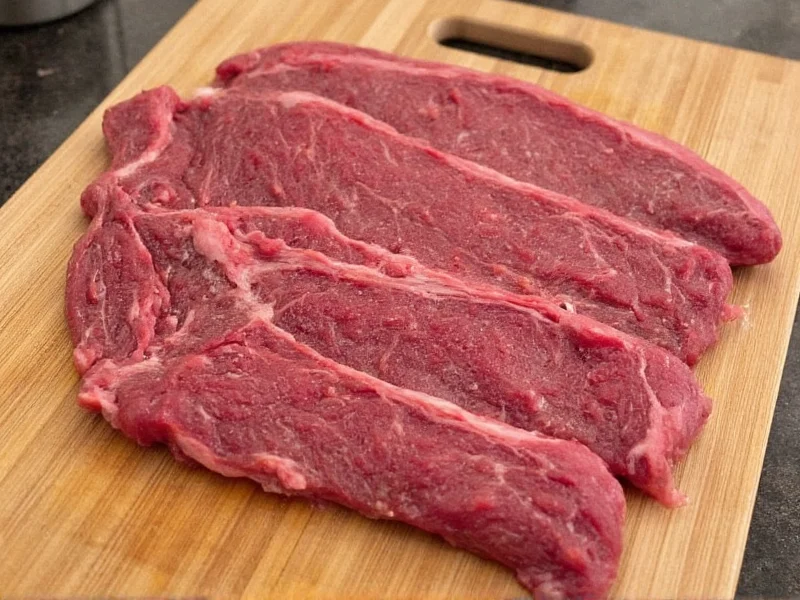Proper seasoning transforms an ordinary beef roast into a culinary masterpiece. The right technique enhances natural flavors without overpowering the meat's inherent richness. Understanding the science behind seasoning timing and ingredient ratios separates amateur results from restaurant-quality dishes.
The Science of Beef Roast Seasoning
Seasoning isn't just about adding flavor—it's a chemical process. Salt dissolves muscle proteins, allowing them to rebind and retain moisture during cooking. This process, called denaturation, begins immediately but reaches optimal effectiveness after 45 minutes to several hours. The timing of your seasoning directly impacts both texture and taste.
Essential Seasoning Components
A successful beef roast seasoning combines four critical elements:
| Component | Recommended Amount | Application Timing |
|---|---|---|
| Kosher salt | 1 tsp per pound of meat | 45 min-48 hours before cooking |
| Freshly ground black pepper | 1/2 tsp per pound | Immediately before cooking |
| Garlic powder | 1/4 tsp per pound | With pepper before cooking |
| Dried herbs (rosemary/thyme) | 1/2 tsp per pound | With pepper before cooking |
Step-by-Step Seasoning Process
Dry Brining Method (Recommended)
- Pat the roast completely dry with paper towels
- Apply kosher salt evenly across all surfaces (1 tsp per pound)
- Place uncovered on a wire rack in the refrigerator
- Allow 1 hour per pound for roasts under 3 pounds, up to 72 hours for larger cuts
- Remove from refrigerator 1-2 hours before cooking to reach room temperature
- Apply pepper and other dry ingredients just before roasting
Immediate Seasoning Method
When time is limited, apply salt at least 45 minutes before cooking. This allows sufficient time for surface moisture absorption and initial protein breakdown. For best results with this method:
- Use coarse salt that won't dissolve too quickly
- Place seasoned roast on a wire rack to prevent sitting in released moisture
- Wipe off excess moisture with paper towels before cooking if condensation forms
Advanced Seasoning Techniques
Dry Rub Variations
Create signature flavors with these professional combinations:
| Flavor Profile | Ingredients (per 3 lb roast) | Best With |
|---|---|---|
| Classic Herb | 2 tbsp kosher salt, 1 tbsp black pepper, 1 tbsp dried rosemary, 1 tbsp dried thyme, 2 tsp garlic powder | Ribeye, sirloin |
| Smoky Southwest | 2 tbsp kosher salt, 1 tbsp smoked paprika, 1 tbsp cumin, 1 tsp chipotle powder, 1 tsp oregano | Top round, chuck |
| Garlic-Herb Butter | 2 tbsp kosher salt, 1 tbsp black pepper, 4 minced garlic cloves, 2 tbsp fresh herbs, 2 tbsp softened butter | Tenderloin, prime rib |
Compound Butter Application
For premium roasts, create a compound butter by mixing softened butter with minced herbs, garlic, and black pepper. Gently separate the meat fibers and tuck small butter portions into the crevices. This technique delivers flavor deep within the roast rather than just on the surface.
Critical Timing Considerations
The timing of your seasoning dramatically affects results:
- Immediate cooking: Salt draws out moisture that doesn't have time to reabsorb, creating a less flavorful crust
- 45-60 minutes before: Surface moisture reabsorbs, creating ideal conditions for browning
- Overnight (dry brine): Salt penetrates deeper, seasoning the interior and improving moisture retention
- Too early (beyond 72 hours): Can create an overly cured texture in some cuts
Common Seasoning Mistakes
Avoid these frequent errors that compromise your roast:
- Using table salt instead of kosher: Table salt's finer grains create uneven seasoning and potential over-salting
- Adding pepper too early: Causes burning during high-heat searing
- Seasoning only the top surface: Creates uneven flavor distribution
- Not accounting for roast size: Using the same amount regardless of weight
- Skipping the drying step: Moisture prevents proper browning and crust formation
Adjusting for Different Cuts
Not all beef roasts season the same. Consider these cut-specific adjustments:
- Fatty cuts (ribeye, prime rib): Reduce added fats in seasoning; focus on complementary herbs
- Lean cuts (tenderloin, eye of round): Include moisture-retaining elements like mustard paste or olive oil in rubs
- Connective tissue-rich cuts (chuck, brisket): Use bolder seasonings that penetrate during long cooking
- Thick vs thin cuts: Adjust dry brine time based on thickness, not just weight
Professional Tips for Perfect Seasoning
- Always measure salt by weight rather than volume for accuracy
- For large gatherings, season individual portions after carving rather than the entire roast
- When using garlic, opt for powder in dry rubs to prevent burning; fresh garlic works better in compound butters
- Acidic elements (like citrus zest) should be added just before cooking to maintain brightness
- For competition-style roasts, inject a seasoned broth into thicker sections before dry brining











 浙公网安备
33010002000092号
浙公网安备
33010002000092号 浙B2-20120091-4
浙B2-20120091-4